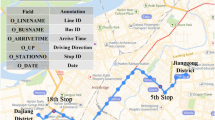Abstract
Quantifying factors that affect bus travel time along arterials is necessary to prioritize investments to reduce bus travel time and its variability and to design advanced prediction and traveler information systems. The joint effects of bus stop location (near vs. far side), intersection delay and traffic conditions on travel time have not been addressed in the literature. To fill this research gap, this study integrates detailed transit, signal phase and traffic data at the stop-to-stop level. Statistical modeling results indicate that red time and the proportion of red time per cycle are the key traffic signal timing factors that affect bus stop-to-stop travel time variability. Bus stop location also has a statistically significant effect on intersection signal delay and passenger boarding times. The impact of traffic volumes on delay is not as high as signal delay but it is significant and varies drastically by segment and time of day.



Similar content being viewed by others
References
Abkowitz MD, Engelstein I (1984) Methods for maintaining transit service regularity. Transp Res Rec 961:1–8
Albright E, Figliozzi M (2012) Schedule recovery for late buses: what are the individual and joint contributions of Transit Signal Priority and bus operator behavior? Working paper
Bertini RL, El-Geneidy AM (2004) Modeling transit trip time using archived bus dispatch system data. J Transp Eng 130:56–67
Ceder A (2007) Public transit planning and operation: theory, modelling and practice. Elsevier, Amsterdam
Diab EI, El-Geneidy AM (2012) Understanding the impacts of a combination of service improvement strategies on bus running time and passenger’s perception. Transp Res Part A Policy Pract 46:614–625
Diab EI, El-Geneidy AM (2013) Variation in bus transit service: understanding the impacts of various improvement strategies on transit service reliability. Public Transp 4:209–231
Dueker KJ, Kimpel TJ, Strathman JG, Callas S (2004) Determinants of bus dwell time. J Public Transp 7:21–40
El-Geneidy AM, Hourdos J, Horning J (2009) Bus transit service planning and operations in a competitive environment. J Public Transp 12:39–59
El-Geneidy AM, Horning J, Krizek KJ (2011) Analyzing transit service reliability using detailed data from automatic vehicular locator systems. J Adv Transp 45:66–79
Feng W (2014) Analyses of bus travel time reliability and transit signal priority at the stop-to-stop segment level. Dissertations and theses
Figliozzi M, Feng W (2012) A study of headway maintenance for bus routes: causes and effects of “bus bunching” in extensive and congested service areas (no. OTREC-RR-12-09). Portland State University, Portland
Furth P, SanClemente J (2006) Near side, far side, uphill, downhill: impact of bus stop location on bus delay. Transp Res Rec J Transp Res Board 1971:66–73. doi:10.3141/1971-10
Kim S (2013) The R package. http://cran.r-project.org/web/packages/ppcor/index.html. Accessed 10 June 2014
Levinson HS (1991) Supervision strategies for improved reliability of bus routes (NCTRP Synthesis of Transit Practice)
Mazloumi E, Currie G, Rose G (2010) Using GPS data to gain insight into public transport travel time variability. J Transp Eng 136:623–631
Mazloumi E, Moridpour S, Currie G, Rose G (2012) Exploring the value of traffic flow data in bus travel time prediction. J Transp Eng 138:436–446
McKnight C, Levinson H, Ozbay K, Kamga C, Paaswell R (2004) Impact of traffic congestion on bus travel time in northern New Jersey. Transp Res Rec 1884:27–35
Milkovits M (2008) Modeling the factors affecting bus stop dwell time: use of automatic passenger counting, automatic fare counting, and automatic vehicle location data. Transp Res Rec 2072:125–130
Slavin C, Feng W, Figliozzi M, Koonce P (2013) A statistical study of the impacts of SCATS adaptive traffic signal control on traffic and transit performance. Transp Res Rec 2356:117–126
Strathman J, Dueker K, Kimpel T, Gerhart R, Turner K, Taylor P, Callas S, Griffin D, Hopper J (1999) Automated bus dispatching, operations control, and service reliability: baseline analysis. Transp Res Rec 1666:28–36
Strathman JG, Dueker KJ, Kimpel T, Gerhart RL, Turner K, Taylor P, Callas S, Griffin D (2000) Service reliability impacts of computer-aided dispatching and automatic vehicle location technology: a TriMet case study. Transp Q 54:85–102
TriMet (2013) Data resources derived from BDS card data
Turnquist MA (1981) Strategies for improving reliability of bus transit service. Transp Res Rec 818:7–13
Acknowledgments
The authors gratefully acknowledge the National Institute for Transportation Community (NITC) for funding this research. We thank Steve Callas and David Crout from TriMet who have provided valuable assistance, advice, and bus transit data as well as match for the NITC project. The authors would also like to thank Willie Rotich from the Portland Bureau of Transportation for providing SCATS and TSP data and valuable assistance. Any errors or omissions are the sole responsibility of the authors.
Author information
Authors and Affiliations
Corresponding author
Rights and permissions
About this article
Cite this article
Feng, W., Figliozzi, M. & Bertini, R.L. Quantifying the joint impacts of stop locations, signalized intersections, and traffic conditions on bus travel time. Public Transp 7, 391–408 (2015). https://doi.org/10.1007/s12469-015-0105-8
Published:
Issue Date:
DOI: https://doi.org/10.1007/s12469-015-0105-8




